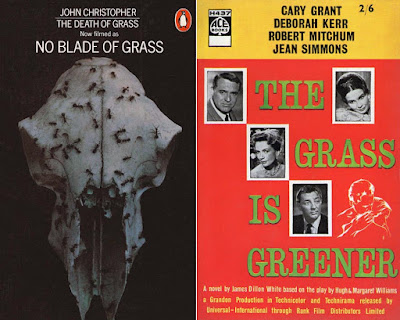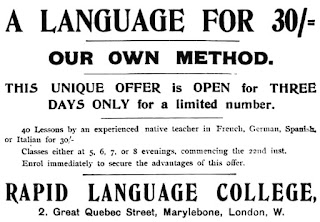ALBERT MORROW
by
Robert J. Kirkpatrick
Albert George Morrow was best-known as a poster artist, designing and painting hundreds of posters from 1890 onwards, mainly for the theatre. But he was also a prolific illustrator for magazines and periodicals, and, to a lesser extent, of children’s books. He was also a rather colourful character.
He was born on 26 April 1863 in Comber, County Down, the son of a painter and decorator from Clifton Street, Belfast. (His obituaries gave his father’s name as George, whereas his 1887 marriage certificate showed his father as Charles Morrow). He was the first of seven brothers, four of whom also went on to become artists and illustrators: George (1869-1955), Jack (1872-1926), Edwin (1877-1952), and Norman (1879-1917). He was educated at the Belfast Model School and then, between 1875 and 1881, at the Belfast Government School of Art. In 1879 he won first prize in an open competition in The Graphic for a black and white drawing, and a year later he won a prize from The Magazine of Art. During much of his school career he was an active member of the local Band of Hope, part of the Irish Temperance League.
In 1881 he was awarded a two-year scholarship at the South Kensington School of Art, worth £52 a year. Most sources that refer to this (previously-published brief biographies and newspaper articles) suggest that he attended the South Kensington School from 1882 onwards – however, he was clearly there in April 1881, as he was recorded in that year’s census as an art student, boarding at 19 Hasker Street, Chelsea, with Robert Cookman, a butler.
When he left South Kensington he joined the staff of The English Illustrated Journal, in particular drawing industrial scenes from locations all over the country. He designed his first theatrical poster in around 1890 – by his own account (in an interview in the magazine The Poster in January 1899) this was for a production of The Stranglers of Paris, or The Grip of Iron (which had first been performed in 1883). The poster was printed by Clement Smith & Co., a well-established theatrical poster company, for whom Morrow went on to design several more posters. In 1891 he joined the London branch of David Allen & Sons, of Belfast, another printing company which produced posters, postcards etc. One of Morrow’s best-known posters, printed by David Allen, was for the satirical comedy The New Woman, written by Sydney Grundy and which premiered in 1894.
Morrow went on to work for David Allen & Sons until at least 1907. He was, at some point, obliged to change his working methods, revealing in The Poster that he used to paint his posters full size in distemper, but printing methods meant that it became necessary to reduce the size of the original which was then mechanically enlarged, a process he thought to be “completely wrong.” He also insisted on doing his own lettering on his posters, saying that this should form an essential part of the design. In addition to his work for David Allen, he produced a series of posters, on his own account, for Alfred Harmsworth’s cheap weekly Answers.
In the late 1890s, Morrow began performing at the monthly Smoking Concerts at the Press Club, in Wine Office Court, Fleet Street, producing quick-fire sketches of the members and guests.
In the meantime, Morrow had married Louisa Anna Finch (born in Chelsea in 1867, the daughter of Richard Finch, a mason) at St. Gabriel’s Church, Pimlico on 29 August 1887. They subsequently lived at a number of addresses, including 67 Winchester Street, Pimlico; 26 Alderney Street, Pimlico; 324 King’s Road, Chelsea; 35 Albert Mansions, Battersea; and 9A Cambridge Road, Battersea, until in January 1899 Morrow filed for divorce. In his petition (held at the National Archives) he claimed that his wife had committed adultery with William Lovesey Preston, beginning in October 1897. For his part, Preston denied this; so, too, did Morrow’s wife – indeed, she responded that Morrow was “a man of violent temper and of very intemperate habits.” She claimed that he had begun ill-treating her in 1896, and that “he frequently as well when he was intoxicated as at other times in gross filthy and obscene language abused [her] and swore at her and assaulted and beat and struck her and in divers other ways was guilty of cruelty….” This, of course, sits rather uneasily with Morrow’s earlier involvement in the temperance movement….. The marriage was subsequently formally ended in January 1900.
Morrow maintained his somewhat peripatetic lifestyle, moving to 4 Stamford Bridge Studios, Chelsea, in 1901. On 5 June 1901, giving his address as The Coach and Horses Hotel, Kew, Morrow married Phyllis Dorothy Grimmé (born in 1875 in Chelsea, the daughter of Francis Louis Grimmé, an electrician, who was living at 12 Clydesdale Road, Notting Hill), at St. Anne’s Church, Kew. They went on to have two children: Albert John, born in Brentford, Middlesex, in 1902; and Phyllis Dorothy Mary, baptized at Ickford, Buckinghamshire, on 22 May 1904. The family subsequently moved to 1 Albert Studios, Albert Bridge Road, Battersea. By 1907, they had re-located to Penn Road, Beaconsfield, Buckinghamshire; and they subsequently moved to Studio House, Kingsway, Gerrard’s Cross, Buckinghamshire (1911), and Silverton, Ledborough Lane, Beaconsfield (1915).
Besides his poster work, Morrow was also in demand as an illustrator for periodicals and magazines. As well as in The English Illustrated Magazine, his work appeared in The Cornhill Magazine, Sunday at Home, The Illustrated London News, The Studio, Sylvia’s Home Journal, The Sketch, The Poster, The Art Journal, The Sheffield Weekly Telegraph (for which he illustrated a serial story in 1905), Lloyd’s Magazine, The Graphic, The Sphere, Good Words, Little Folks, Lazy Land, Short Stories, Illustrated Bits, Cassell’s Magazine, The New Magazine, The Strand Magazine and Punch. He also supplied illustrations to several boys’ periodicals, including Ching Ching’s Own, The Boys’ Friend, The Boys’ Leader, Big Budget, The Boy’s Own Paper, Chums and The Captain.
As a book illustrator, he worked for a variety of publishers, and illustrated a wide range of books, mainly those published for children. Amongst the authors whose novels he illustrated were Amy Le Feuvre, Wilkie Collins, H. Rider Haggard, Harold Avery, Gordon Stables and Christine Chaundler. He also illustrated re-issues of novels by Frederick Marryat and R.H. Dana. (Much of his book work remains unrecorded).
He also provided illustrations for numerous children’s annuals from around 1918 onwards, in particular those from Blackie & Son, F. Warne & Co., and the Oxford University Press.
As an artist, Morrow exhibited several times at The Royal Academy, beginning in 1894, and in 1903 he exhibited at the first annual exhibition of the Ulster Arts Club in Belfast. Four years later the Ulster Arts Club gave him the honour of a solo exhibition.
In the 1920s he claimed to have done a lot of work for Cassell & Co., although most of this has yet to be identified. He had moved from Buckinghamshire to Sussex, where he died, at Whitemore, West Hoathly, on 26 October 1927, being buried in the churchyard of All Saints Church, Highbrook, Hoathly. His gravestone was designed by the architect Albert Toft (1862-1949), with whom Morrow had been a close friend since they met at South Kensington in 1882. His estate was valued at a mere £91, suggesting that he had lived life to the full, no doubt fully immersing himself in the Bohemian world of the London theatre and Fleet Street, and had been profligate in spending what would have been substantial earnings.
His widow died on 5 December 1978 in Lindfield, Sussex, leaving an estate valued at £5,048.
PUBLICATIONS
Books Illustrated
The Red Thread of Honour, or The Minster Schoolboys by Marianne Kirlew, Oliphant, Anderson & Ferrier, 1891
An Artist in the Himalayas by A.D. McCormick, T. Fisher Unwin, 1895
The Infant by Frederick Wicks, Remington & Co., 1895
The Purloined Prince by Edgar Turner & Reginald Hodder, The Caxton Press, 1905
Mirian Lemaire, Moneylender by Coralie Stanton & Heath Hosken, Cassell & Co., 1906
The Mender by Amy Le Feuvre, R.T.S., 1906
The Midnight Guest by Fred. M. White, Cassell & Co., 1907
Sir Walter Raleigh: An Historical Romance by William Devereux & Stephen Lovell, Greening, 1910
Noel and His Star by Kaye Maud Johnson, Religious Tract Society, 1913
No Name by Wilkie Collins, Collins, 1915
Whilst Father was Fighting by Eleanore H. Stooke, R.T.S., 1917
The Mystery Ship: A Story of the “Q” Ships During the Great War by Percy F. Westerman, S.W. Partridge & Co., 1920
The Ancient Allan by H. Rider Haggard, Cassell & Co., 1920
The Happy Comrade by E.L. Haverfield, O.U.P., 1920
The Strange Adventure of Jack Smith by John Finbarr, O.U.P., 1921
The Children of the New Forest by Frederick Marryat, O.U.P., 1922 (re-issue)
The Crimson Ramblers by Violet Bradby, O.U.P., 1922
Between Two Schools by Harold Avery, T. Nelson & Sons, 1923
A Merry Heart by Joan Leslie, O.U.P., 1923
Princess Carroty-Top and Timothy: A Fairy Tale of Today by Christine Chaundler, F. Warne & Co., 1924
Barbara in Charge by M.E. Fraser, R.T.S., 1925
Secrets of the Mountains: A Story for Girls by Mabel L. Tyrrell, F. Warne & Co., 1925
Gunpowder, Treason and Plot by A. Edwards Chapman, F. Warne & Co., 1926
Hideaway House by J. Roland Evans, R.T.S., 1926
The Boy Over the Way by Frederica J.E. Bennett, Religious Tract Society, 1927
Harry Lorrequer by Charles Lever, Readers Library, 1928 (re-issue)
Two Years Before the Mast by R.H. Dana, Readers Library, 1928 (re-issue)
Adrift in the Pacific by Jules Verne, Readers Library, 1928 (re-issue)
Kidnapped by Smugglers by Frederica J.E. Bennett, R.T.S., 1931
Jack Locke: A Tale of the Sea During the Napoleonic Wars by Gordon Stables, F. Warne & Co., (?) (re-issue)
Tales of Hoffman Retold from Offenbach’s Opera by Cyril Falls, Jarrolds, (?)
A Little Mother to the Others by L.T. Meade, F. Warne & Co. (re-issue)
Annuals etc. (various dates)
The Oxford Annual for Scouts, O.U.P.
The Oxford Annual for Boys, O.U.P.
The Golden Budget for Boys, Blackie & Son
The Boys’ Book of School Stories, Blackie & Son
The Bumper Book of School Stories, Collins
Collins Adventure Annual, Collins
The Big Book for Girls, O.U.P.
My Own Story Book, F. Warne & Co.,
Warne’s Happy Book for Boys, F. Warne & Co.,
The Jolly Book, T. Nelson & Sons
Jolly Days for Girls, O.U.P.
The World of Sport and Adventure by Wingrove Willson (ed.), Aldine Publishing Co.,
The Companion Annual, R.T.S.
My Picture Book, Containing Alphabets and Stories, Nursery Rhymes and Fairy Tales, F. Warne & Co.
The British Girl’s Annual, Cassell & Co.








































































































